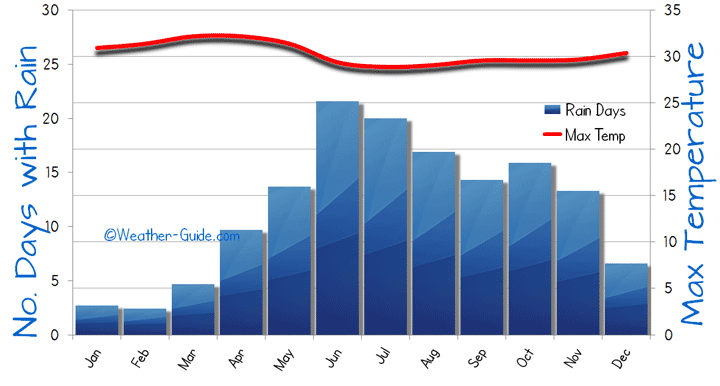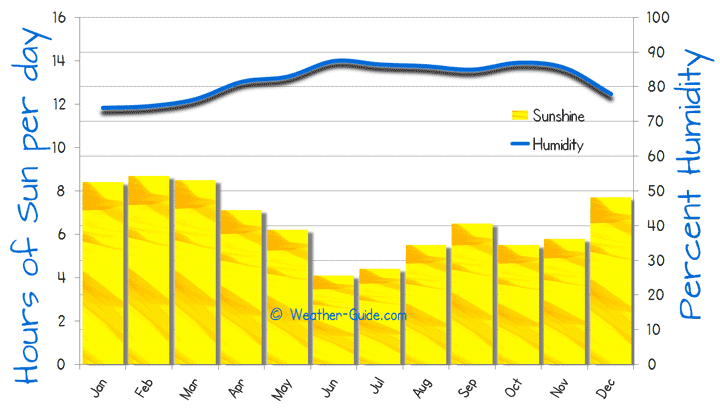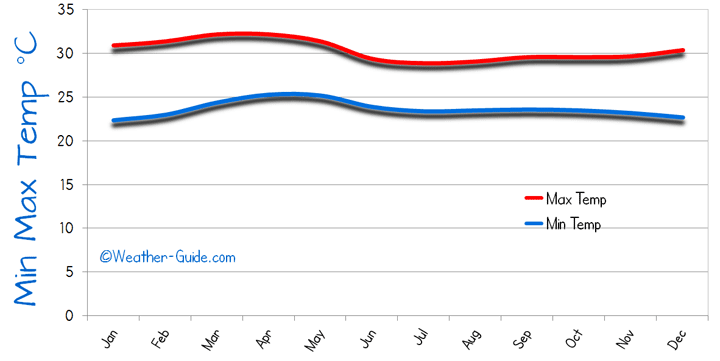Weather-Guide.com
Kollam Weather Averages
The following 3 weather charts display the average weather conditions of Kollam in India. The first chart plots the maximum temperature against the number of wet days per month. The second Kollam weather chart indicates the average humidity levels and the amount of sunshine. The third weather chart of Kollam compares the maximum day time temperature against the minimum night time temperature.
Kollam Weather Chart

The average weather for Kollam, India
Kollam Sunshine and Humidity

The above sunshine and humidity chart display the average conditions for Kollam. The amount of sunshine is the average amount per day while the humidity is expressed as a percent.
Kollam Maximum and Minimum Temperatures

The above chart displays the maximum and minimum temperatures for Kollam, India
More Holiday Weather for India
Agra - Amritsar - Chennai - Delhi - Goa - Kochi - Mumbai - Puducherry - Trivandrum - Varanasi - Alappuzha - Kollam - Kovalam - Varkala - Home
Weather Destinations
Argentina - China - Cyprus - Japan - Ko Samui - Korea - Mexico
New Zealand - Phuket - Portugal - Seychelles - Sri Lanka - Tenerife - Vietnam
City Comparisons
Mexico City - New York - Los Angeles
Holiday Comparisons
When to Visit Kollam
Kollam is the tourist hub for the regions famous backwaters as the city lies on the banks of Ashtamudi Lake. The city does not offer much for visitors but is generally the starting or finishing destination for one of Kerala’s back-water tours, so most visitors end up spending a couple of nights here.
The climate of Kollam and south eastern India is hot and humid almost all year round. The long monsoon season that makes travel almost impossible and the hot season is just too....hot! The best time of year to visit Kollam is from late December through to March while the rest of the year suffers with heavy rains or draining humidity.
This short season is unsurprisingly the height of the tourist season with package resorts booked up and charging full prices. The days in the tourist season are hot with moderate humidity. Do not be surprised to see locals, especially those in uniforms, wearing jumpers and cold weather clothes while you are melting in shorts and t-shirts as this tourist season is their cold season
The temperatures rapidly increase during May and are their highest during April. This heat rapidly evaporates water from regions many water waterway and brings up humidity to almost complete saturation. Drink lots of water and wearing loose clothes does nothing to make the temperatures bearable.
The first of the two monsoons arrive in June and the residents of Kollam welcome the break from the heat that the rains bring but they also bring flooding and misery to tourists. The torrential rains that originate from the Arabian Sea over whelming the poor infrastructure making travel difficult and diseases are rife. The monsoon rains last solidly for days and continue for months. It is hard to decide which season is worse for tourist, either the hot season or the first monsoon season, the best advice is to avoid both.
The second monsoon comes in from the North West and though delivers less water lingers for longer. The end of the monsoon which is funneled out of Kerala can last well into December with gray days with short showers; not great for beach weather. These monsoon rains end much earlier in Goa. While Kollam may be having poor weather further up the western coast may be experiencing pleasant weather.